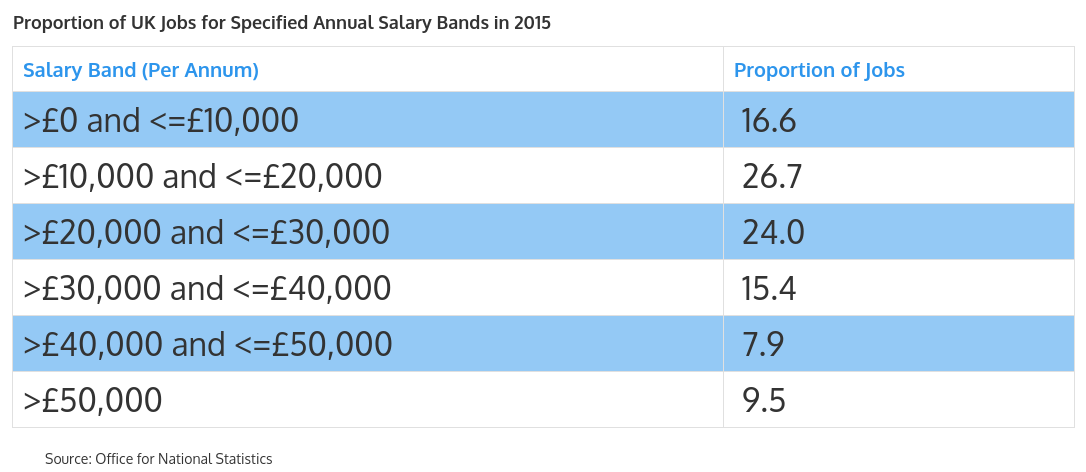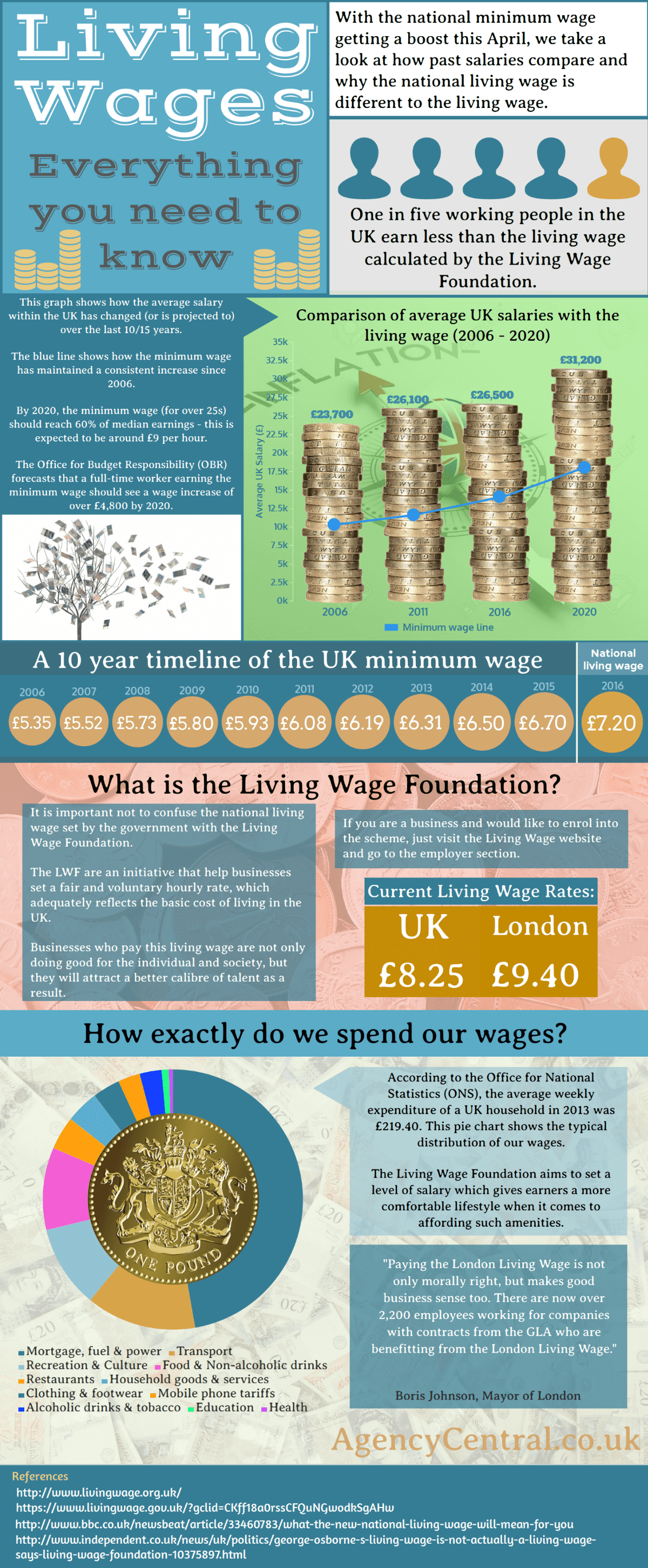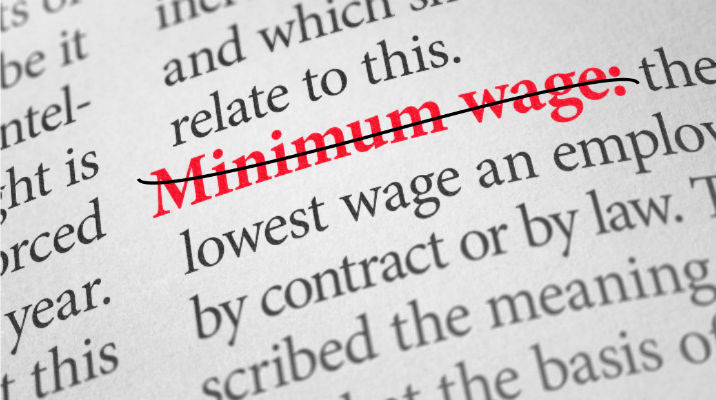As you’re no doubt aware, there’s going to be a big shake-up in the minimum wage this year – with it set to rise by 50p per hour for over-25s and being rebranded as the ‘national living wage’. But what does this mean for your business, the recruitment industry, or the economy in general?
What is the national living wage?
On April 1st 2016, the UK’s minimum wage will change its name to the national living wage – going from £6.70 per hour for over 21s to £7.20 per hour for over 25s. This applies to everyone living in the UK – no matter where they live, and the government has outlined ‘an ambition’ that the minimum wage for people over 25 should reach 60% of median earnings by the year 2020. It is estimated that this will mean a minimum wage of around £9 per hour by that point. Based on this, the Office for Budgetary Responsibility (OBR) estimates that a full-time worker who currently earns the minimum wage would earn over £4,800 more by the year 2020.
The national living wage is not the same as the living wage set by the Living Wage Foundation
We mention this, because it’s more than a little bit confusing. The Living Wage Foundation is an organisation that sets the living wage based on the cost of living – where factors include accommodation and healthy food, as well as some extras such as the purchasing of birthday presents.
This calculated living wage is completely optional for employers (unlike the national living wage amendments put forward to the minimum wage by the UK government, which are not), and has already been implemented by companies including HSBC, KPMG, Aviva and Lidl. Ikea has also stated that it will implement the living wage across its UK stores as of April 2016 (please note that since the linked article was published, the calculated living wage has risen).
Mike Kelly (KPMG’s head of Living Wage) has compared the Living Wage brand to the Fairtrade label. For the business interested in employee welfare and ways that it can introduce more enlightened employment practices, the living wage represents a solution which is likely to be universally popular amongst its lower-paid staff.
As of March 2016, the Living Wage Foundation states the living wage to be £8.25 per hour – or £9.40 per hour in London (the living wage includes a London weighting – unlike the national living wage put forward by the government). This is calculated by the Centre for Research in Social Policy at Loughborough University, and the Greater London Authority (London living wage). In order to achieve the Living Wage Employer Mark, a company must pay at least this figure to every employee they have over 18 years of age. This is in contrast to the national living wage, which will only apply to people aged over 25 years.
What does an annual income on the minimum wage look like, and how prevalent is this level of pay in the UK?
The outgoing 2016 minimum wage for people aged over 21 in the UK is £6.70 per hour. Assuming that someone works a 9 – 5:30 day, and takes one hour for lunch (unpaid) each day, then they will be paid for 7.5 hours each day that they work.
2016 (being a leap year) has 366 days – 105 of which fall on weekends. This gives a total of 261 weekdays. Although 8 of these days are bank holidays, and this employee will be taking a further 20 days as annual leave, these days are still paid by the employer, and are therefore included in this calculation.
6.70 x 7.5 = 50.25 (so the employee earns a gross figure of £50.25 per day worked).
50.25 x 261 = 13115.25 (so the employee earns a gross figure of £13,115.25 per year).
The table below shows that gross annual earning of this size (or even lower) are by no means a rare occurrence in the UK. What is worrying about this situation is that this level is far below what the Living Wage Foundation states to be practical. At the current (April 2016) level of living wage (calculated for a person situated outside of London), which is £8.25 per hour, someone working the hours detailed above would achieve a gross income of £16,149.38 – a whole £3,034.13 (or 23%) more than the person earning the April 2016 minimum wage would have received.
It has been reported that people in the north-west of England will gain the most from the national living wage – with 350,000 (11% of the UK workforce) expecting to see a pay increase.
The problem with the table below is that it includes part-time work (hence the number of annual gross incomes included which are below the standard minimum wage level we calculate above). It should also be noted at this point that low-paid workers are often not the main earner within a household – often taking menial or part-time work in order to supplement the higher income of a partner. Even so, the Joseph Rowntree Foundation recently reported that around 600,000 UK households live below what they deem to be the ‘minimum income standard’ – despite every adult in the group being in full-time employment.

As is usual, income tax thresholds will change on April 1st, 2016
In keeping with past form, many income tax bands will also be changing with the start of the 2016-17 financial year. Given the subject of this article, the main tax boundary of interest here is the one between the personal allowance (the amount of money that a UK citizen can earn before they start to pay income tax) and basic rate income tax (the lowest band – currently set at 20%).
Currently, in early 2016, the threshold at which the majority of people in the UK (i.e. those with a salary below £100,000 per annum) begin to pay income tax is set at £10,600 – but this is set to rise by £200 to £10,800 for 2016-17.
Not paying 20% tax on £200 of your total income won’t make a massive difference, but does mean that many earners will find themselves with an extra £80 per year. This increase is also smaller than that of some previous years. For the 2011-12 financial year for instance, the personal allowance went up from £6,475 to £7,475 – an increase of £1000.
The upper limits for basic rate and higher rate income tax will also change for 2016-17. The basic rate limit will increase from £31,785 to £31,900, and the higher rate limit will increase from £42,385 to £42,700. Given that gains are largely cumulative, higher earners stand to gain something from this situation too.
So what does a minimum wage mean for the economy?
Well, quite simply, as long as businesses can afford to pay it, a compulsory minimum hourly wage should be a good thing for the economy. In business, it can be all too easy to lose sight of the bigger picture, when margins are being cut, targets are being raised, and competitors are licking their lips – but employee satisfaction matters. As we wrote in our recent article on maintaining employee happiness, whilst benefits and love for your job are great, there’s only really one reason that anyone gets up for work in the morning – and (in the UK at least!) it begins with a pound sign.
Whilst the statistic that eight out of ten pay rises are expected to be outside of London and the south-east might sound impressive, this data does bear further investigation.
Most people nowadays accept the fact that happier workers are more productive workers – but there is much more to the minimum wage than simply making sure that people are reasonably satisfied with their pay cheque. It’s there to ensure that people can put food on the table and a roof over their heads after doing a day’s work. Now (understatement of the century alert!), economics is quite a complicated subject, but there are a number of issues to consider here. Namely:
-A minimum wage means that low-paid workers have more money to spend on goods and services in the economy.
This is simple – if your wage increases, then you will be more likely to purchase things. Once your pay rises above subsistence level, these things will begin to include ‘luxury’ items, rather than mere necessities such as basic food, utility bills, or public transportation costs.
-A minimum wage prevents employers from paying extremely low wages – lowering the number of workers who can theoretically be employed to carry out a task.
As an extreme example of this, imagine that the minimum wage was suddenly raised to £50 per hour overnight. How many workers could the average retail or food service business (two sectors where low wages are traditionally prevalent) now afford to employ? What this shows is, that raising the minimum wage can be dangerous – because many businesses would simply cut the number of people they employ in order to pay for the increase. Unemployment would therefore begin to rise.
-If everyone in the economy had more money, then prices would rise because businesses would be keen to profit from the situation. This is a simple case of supply and demand.
For instance, if everyone in Britain suddenly had a disposable income of £1000 or more per month after paying for the necessities in their life, prices for things like restaurant meals, holidays, and designer clothes would almost certainly rise in a largely proportionate manner as demand for them went up. This is inflation in action.
Could too drastic a rise in the minimum wage actually be counter-productive?
Although economics is an at times poorly-understood and sometimes lambasted discipline, the scenarios above underline the fact that simply setting a higher minimum wage level may not be the panacea that it appears to be on the surface. No matter what one’s perspective on the situation is, it is important to acknowledge the fact that a sudden jolt to the lower reaches of the pay scale could have negative implications for many of the people it was intended to help – potentially encouraging / forcing businesses to cut jobs, or raising inflation and thereby defeating its own objective.
One alternative solution would be raising the tax free personal allowance level to that of an average minimum wage earner’s yearly income – which would sidestep the problem of businesses cutting jobs to balance an increase in wages. The problem with this is that it effectively moves the responsibility for paying a living wage from the private sector to the public purse – meaning that the country would almost certainly experience a reduction in government spending, along with all the knock-on effects that such a scenario entails.
Whilst no one can be certain whether the negative scenarios detailed above would actually unfold if the minimum wage was suddenly and dramatically raised, they do explain why a government might be reluctant to bring in such a change overnight. In this sense, the ‘little and often’ approach to minimum wage reform put forward by the British government makes more sense.

What does the national living wage mean for the recruitment industry?
Given the market we’re in, Agency Central is particularly interested in what the national living wage might mean for the UK’s recruitment industry. From the discussion above, it’s easy to see why a rise in the minimum wage might have a knock-on effect – changing the way in which companies recruit staff, or even slowing down the process itself. In order to get a view from the front line of the recruitment industry, we spoke to the founder of executive search firm Re: Find, James Cumming – who had the following to say on the matter:
“I think that the national living wage is going to be a very interesting issue in coming months. My personal view is that this might well impact hiring, because it’s going to have definite cost implications for business. Firms are likely to start thinking slightly differently about a number of issues when they’re hiring – including:
-The sort of people they employ.
-How many people they employ.
-Ways they might use technology in order to get around having to employ so many people in the first place.”
On the technology front, James cites automotive manufacture as an example of how costs have been cut by replacing human workers with machines – whilst self-service checkouts in supermarkets represent a way in which this might spill over into our everyday lives as consumers.
“Larger businesses might also look into outsourcing the way they deal with any central services – asking questions about whether or not they really need to be carrying out tasks like accounts or IT internally.”
The points made by James ring true here – with the use of technology to replace workers a subject which is gaining traction in the media. Traditionally the domain of specialist manufacturing, robotic or mechanised methods of getting things done will become a more attractive prospect for employers as development costs fall, and the cost of employing a low-paid worker becomes more expensive as the minimum wage rises.
The cost of implementing the national living wage will be higher than the cost of simply raising minimum wage pay rates
Quite simply, this is because firms will find themselves having to pay what are known as ‘spillover’ costs in order to maintain the difference between entry-level incomes and those at higher levels. For instance, if a retail chain pays its starting employees the minimum wage, but its management staff two pounds an hour over this level, then when the minimum wage rises (changes its name to the national living wage), management staff will probably want to know why the gap between compensation has dropped.
In order to avoid this situation, many companies will be likely to couple the onset of the national living wage with a rise in pay for many of their employees with higher levels of hourly – or even salaried – compensation. This will mean that the implementation of the national living wage will have costs higher than simply raising all wages to at least £7.20 per hour for over 25s – hence ‘spillover’ costs.
Why does the minimum wage / national living wage not include a separate band for residents of London?
It is widely known that living in the UK’s capital is a good deal more expensive than anywhere else in the country, and many organisations therefore offer a ‘London weighting’ when it comes to setting salaries – paying employees in the region proportionately more in order to take account of this.
Again, here it is important not to confuse the government’s national living wage with the higher living wage put forward by the Living Wage Foundation – which does include a higher level for London. The national living wage does not include this higher level – something which on the surface is more than a little confusing, given that living costs are clearly higher in the capital.
One possible reason for this disparity might be to address exactly this issue – meaning that jobs with lower pay might become more attractive in areas outside of London than they are in the capital. This might encourage mobility amongst employers and workers in a country which is largely south-east-centric (at least where the economy is concerned).
It has been reported that people in the north-west of England will gain the most from the national living wage – with 350,000 in the area (representing 11% of the UK workforce) expecting to see a pay increase by 2020. Interestingly whilst on this point, 65% of the total workers expecting to make gains are women. Overall, an estimated eight out of ten pay rises directly attributable to the national living wage are said to be expected outside of London and the south-east.
Whilst the statistic that eight out of ten pay rises are expected to be outside of the south-east might sound impressive, this data does bear further investigation. Eight out of ten equates to 80% – and calculated from the government’s statistics, the precise figure is actually 81.5%.
But the above must be seen in light of the fact that only around 26.6% of the UK’s population actually live in London and the south-east (calculated using 2011 Census statistics). This means that 73.4% of the UK’s population lived outside of the London and south-east region as of 2011. In this light, the fact that 81% of the UK’s lowest salaries are also located outside of this region is hardly surprising when one considers the high concentration of wealth in the capital and its surrounding area.
If anything, the main revelation that can be drawn from this figure is how many people in London are currently paid below the level that will be set for the national living wage. With the Living Wage Foundation suggesting that £9.40 per hour is a workable income for someone living in the capital, to discover that 200,000 people living and working there (the same number as for the whole of Scotland) currently earn less than £7.20 per hour is surprising, and raises serious questions about levels of working poverty in London.
So what does all this tell us? What changes can we expect to see from the implementation of the national living wage?
What we’ve seen from this article is that while the national living wage is far from perfect, it represents a step in the right direction when it comes to improving low pay in the UK. Whilst it would be nice if the government and business community could wave a magic wand in order to ensure that every worker in the country has enough money to sustain a reasonable lifestyle, in reality the situation is quite a bit more difficult than this.
The economy is a complicated beast, and the possibility of widespread inflation means that salaries cannot simply be raised across the board without risking a knock-on scenario which could negate any positive effect the rise might have. Whilst the national living wage falls short of the living wage calculated by the Living Wage Foundation, as our infographic shows, it represents a step up in the trend line for the minimum wage – which can be no bad thing for people in entry-level positions.
Whilst there are knock-on or so-called ‘spillover’ costs associated with the national living wage, and it will clearly increase the pay burden on UK businesses, it seems unlikely that the economy will grind to a halt. The change is not so great that it risks a sudden shock to the economy – with a prescribed programme of increases up until the year 2020 meaning that its legacy will continue the process of gradual improvement.
Although some businesses are already finding ways in which they can mitigate the increased costs brought on by the national living wage by attempting to further drive productivity, or even by cutting staff numbers, others are likely to take a different approach. By allowing higher wages to naturally increase employee satisfaction and productivity, these businesses are likely to hope that they can weather the increased costs without any great upheaval.
This progressive approach recognises that what is good for an employee can also be good for a company – and indeed, the economy in general. Whilst time will tell which of these situations is the more realistic, one might hope for the latter.



